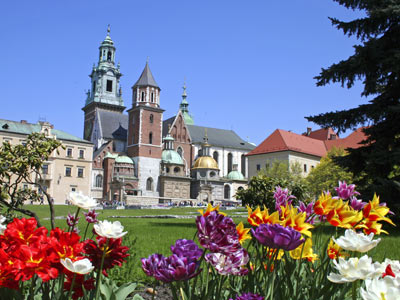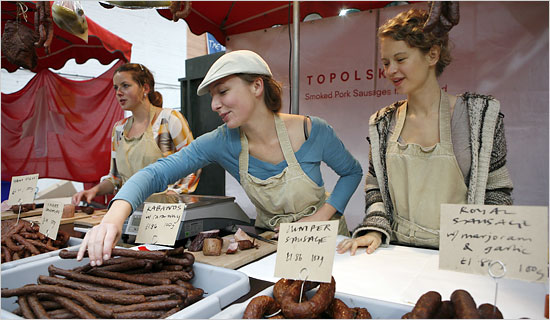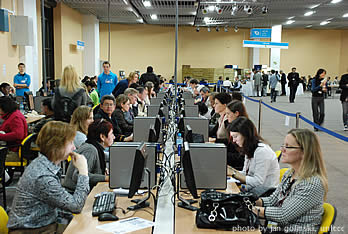Has Transition Left Women Behind?
Polish Women’s Labour Markets at
‘Home’ and ‘Abroad’
by Angela Coyle
Earlier this year Lech Kaczynski, the President of Poland, famously commented on
the “…impossibility of finding a decorator in Warsaw.”

He was alluding to the skills shortages that Poland is now experiencing as a result of emigration. Poland is regarded as one of the most successful of the new EU Member States, yet in common with other new market economies in Central and Eastern Europe, high levels of economic growth has not resulted in significant job growth. On the contrary, economic restructuring has created a large pool of surplus labour, and Poland has shifted from a labour market of full employment to having one of the highest levels of unemployment in the EU 25.

As a result, large numbers of Polish nationals Equal at work – it pays off have left to find alternative employment in other European states. The Polish government estimates that at any given time more than 2 million Poles, mostly in their 20s and 30s, are working abroad. The migrant Polish construction worker is a popular stereotype across Europe even though around half of Polish labour migrants in Europe are women. Both women and men have been affected by Poland’s transformation, but women have been disproportionately affected by job loss, unemployment, impoverishment, and gender discrimination. Emigration has enabled women to find new work opportunities across Europe as cleaners, nannies, care workers, and nurses.
While this is a ‘success story’ of sorts, the exodus of young women is depleting Poland of its mothers and daughters and large swathes of human and social capital. It is Poland’s ‘care drain’, rather than a shortage of painters and decorators, that is now in need of attention.

Will Poland’s Future Generation will Pay the Price…..from lack of nurture?
Labour market transformations and
gender inequality in Poland…
Prior to the 1990s, Polish women had the highest female employment rates in Europe. They were well represented in higher level, scientific and managerial occupations and well supported by state-funded family and welfare services including comprehensive nursery and childcare facilities. Now, Polish female employment rates are 47.8 percent, far lower than the EU-25 average female employment rate of 57.3 percent. The female unemployment rate is 14.2 percent, the highest in Europe and exceeds both Polish men’s unemployment rate (11.2 percent) and the average female unemployment rate (8.6 percent) in the EU-25. Many older women (aged 55+) have withdrawn from the labour market altogether with employment rates of just 19.4 percent, compared with 34.1 percent for Polish men aged 55+ and 31.7 percent for women aged 55+ across the EU-25.3
Education does not protect women against unemployment: unemployed women are better educated than unemployed men.

Over 50 percent of unemployed women have secondary, post-secondary or tertiary education, as opposed to 32 percent of unemployed men.
Market transformations affected women’s jobs first and disproportionately because they were concentrated in a very narrow band of industries, especially textiles and clothing, and in state-run public services, including health, education, and social work that were all subject to early restructuring. Job loss in these female-dominated labour markets has not been offset by any significant new employment opportunities in the private sector, which is distinguished by overt gender discrimination in employment practices. These detrimental effects of labour market restructuring have been compounded by the lack of institutional support for the promotion of gender equality.

On the contrary, thousands of day-care centres and nurseries that supported working women have closed down and European discourses of gender equality are unwelcome.
In the years prior to European enlargement, the EU frequently raised its concerns about the Polish state’s apparent disregard for EU equal treatment directives and the lack of harmonization with EU gender equality and employment targets. EU labour-market strategies are based on responses to the twin challenges of an aging population and a diminishing workforce.
Promoting equal opportunities for women and men, including equal pay, childcare and the better reconciliation of working and home life, is seen as the best way of increasing female labour-force participation and thereby activating Europe’s full labour-force potential in the face of demographic decline.

Poland is a long way from the EU target of female labour-force participation rates of 60 percent.
At the same time, Poland’s fertility rates are the lowest in the EU. High unemployment, low household income, and high levels of women’s labour migration are not conducive to family formation.
Polish women and labour migration
Both women and men have resorted to migration in response to the lack of employment opportunities in Poland’s new market economy. Mobility, not employment, is the new opportunity created by transformation. As most of this labour migration has been irregular and circular, its scale is very difficult to quantify.

Around 1 million Poles are thought to have sought work outside of Poland every year since 1989; approximately half have been women. In fact, Polish women have very much been at the forefront of this new paradigm of cross-border working and transnational lives.
Many have children living in Poland and travel back and forth across borders between work and their families. They believe themselves to be more like long-distance commuters rather than migrants or settlers. They are not concerned with assimilation or settlement; they maintain their lives in Poland by email, cheap phone calls and low-cost travel.

Although the experiences of Polish migrants in Europe are heterogeneous, there are some distinct features of their working abroad. Germany, the Netherlands, France and Britain have been favoured destinations; migrants have taken advantage of various means of legal entry available such as student visas or seasonal worker schemes, but they work in breach of their conditions of entry. For both women and men, migration has been deskilling.

Their undocumented, irregular status forces them into low-paid, unskilled, and informal work.
They are ‘high-quality migrants in low-wage jobs’. Polish nationals have all but taken over seasonal jobs in agriculture and construction in Europe. Polish women staff the new army of domestic workers in Europe, working as cleaners, childminders and carers, frequently in private households.
Polish women’s decision to work abroad cannot be understood in employment terms alone. It is clear from their narratives that they want to be part of a new, modern, cosmopolitan Europe.

They want to be socially mobile and independent economic actors, not men’s dependents. Many professionally qualified women such as nurses and teachers prefer to work in Europe in these kinds of occupations than to remain working in Poland.
This is an opportunity to speak English and live abroad and, while their work is not well paid, they can earn more than they would at home.

In 2004, Poland became part of the enlarged EU; Britain, Ireland and Sweden immediately adopted an open-door policy extending the right of Polish nationals to work there. Now an estimated 600,000 Poles are thought to be working in Britain and a further 250,000 in Ireland. These arrangements allow these countries to improve the selective recruitment of skilled migrant workers; over time, it should enable qualified Polish women to access more skilled work.

The UK is employing increasing numbers of Polish women as nurses and as care assistants in hospitals and residential care homes. Still, hard facts on the extent and experience of Polish labour migration remain patchy. Many Polish women in the UK are still ‘invisible’, choosing not to regularize their status through the Workers Registration Scheme (WRS–although knowledge of the WRS is not widespread).

The key to understanding Polish women’s labour migration is that they do not plan to stay. Even though they can’t quite envisage when they will be able to return home, they regard their international commute as wholly temporary.
Sustainable futures?
Migration has helped ease the unemployment and socio-economic insecurity experienced in Poland as a result of economic transformation. Poles have proved themselves to be a hard-working, flexible, and useful labour supply in Europe.

However, migration invariably depletes labour-sending countries of the skills needed for sustainable economic development. When women migrate it is not just their labour-force contribution that is lost: also lost is the unpaid work of social reproduction that women perform as carers of families, children, and older people, and which is vital to social sustainability. Until Poland can offer women work opportunities within a framework of gender equality and equal rights at home, it is hard to imagine why they will return.
Angela Coyle is Professor of Sociology at City University London and has worked extensively as a consultant on Gender issues in Central and Eastern Europe.
Source: http://www.developmentandtransition.net







